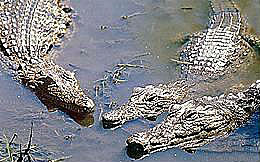 Framed by glowing sunsets and a bountiful
canopy of stars, lies the Kruger National Park. The park, rich in
biodiversity, was established in 1898 and stretches for 350km (approx
140 miles – within the park itself the road network measures in at
about 1300 miles) from the south to north along the Mozambican border
before meeting up with the Zimbabwean border. A paradise for the
wildlife enthusiast with close to 150 mammals to be on the look-out
for, amongst them six cat species, the park also has more than 500
species of birds and over 300 species of trees for the visitor to
identify. With its subtropical climate, the large habitat variety and a
surface area of 19 633km², the park is home to a spectacular
array of fauna and flora and is undoubtedly the world leader in dynamic
environmental management techniques and policies based on experience
gained over more than a century.
Framed by glowing sunsets and a bountiful
canopy of stars, lies the Kruger National Park. The park, rich in
biodiversity, was established in 1898 and stretches for 350km (approx
140 miles – within the park itself the road network measures in at
about 1300 miles) from the south to north along the Mozambican border
before meeting up with the Zimbabwean border. A paradise for the
wildlife enthusiast with close to 150 mammals to be on the look-out
for, amongst them six cat species, the park also has more than 500
species of birds and over 300 species of trees for the visitor to
identify. With its subtropical climate, the large habitat variety and a
surface area of 19 633km², the park is home to a spectacular
array of fauna and flora and is undoubtedly the world leader in dynamic
environmental management techniques and policies based on experience
gained over more than a century.
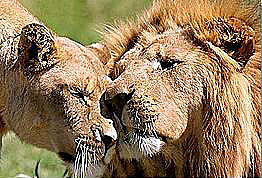 Most
national parks also offer organised night drives or early morning
drives in park vehicles with guides, but they have to stay on the road
and take place at set times, so many people hire a car themselves to
explore the parks on their own. Most parks have rest camps, and
— depending on the park – a range of accommodation,
from camps and huts to bungalows and guest houses. Most accommodation
is equipped with self-catering facilities, although many camps do have
shops, and some have restaurants.
Most
national parks also offer organised night drives or early morning
drives in park vehicles with guides, but they have to stay on the road
and take place at set times, so many people hire a car themselves to
explore the parks on their own. Most parks have rest camps, and
— depending on the park – a range of accommodation,
from camps and huts to bungalows and guest houses. Most accommodation
is equipped with self-catering facilities, although many camps do have
shops, and some have restaurants.
In the last 20 years most of the fences have been
removed between the private reserves and South Africa’s
Kruger National Park, allowing game to roam freely. The most
famous of the parks is
Sabi Sands where you can find well known lodges such as
Londolozi, Singita and Mala Mala. The
Timbavati area is slightly further north and is well known
for its large populations of elephant and buffalo.
When to Go
Between October and March, when summer rains transform
the dry landscape into a flowering paradise, the park is alive with
baby buck and migratory birds, but at the same time temperatures can
hit over 105°F (40°C), dropping to 68°F
(20°C) in the evenings. The foliage can often hide game, and
this is when the risk of malaria is at its highest so you are advised
to take a course of anti-malaria drugs.
 In
the winter, when water is scarce and the plant life dies back, the
animals are easier to spot, especially at water holes and riverbeds.
This is the most popular season, so be prepared to share your safari
with other motorists. The days are warm, but temperatures can drop
close to freezing at night, and units are not heated. Try to avoid
going during the school holidays, particularly in winter, when the park
is packed to capacity.
In
the winter, when water is scarce and the plant life dies back, the
animals are easier to spot, especially at water holes and riverbeds.
This is the most popular season, so be prepared to share your safari
with other motorists. The days are warm, but temperatures can drop
close to freezing at night, and units are not heated. Try to avoid
going during the school holidays, particularly in winter, when the park
is packed to capacity.
Driving
Unlike some private game reserves where rangers are
permitted to drive off road, at Kruger you must drives on roads. The
speed limit is 50 kmph on paved roads; 40 kmph on
gravel roads; 20 kmph in the rest camps (30, 25, and 15 mph,
respectively). There are speed traps! You should always stay in your
vehicle unless you’re at a designated picnic site.
Safety
Under no circumstances should you leave your vehicle
unless at a designated site; one story goes that a local ranger left
his game drive to “relieve” himself didn’t survive
to do up his zipper, so make sure to visit the bathroom before leaving
your rest camp.
Entrance and Admission
The entrance gates open from January to February from
5:30am to 6:30pm; March from 5:30am to 6pm; April from 6am to 6pm; May
to July 6am to 5:30pm; August to September 6am to 6pm; October from
5:30am to 6pm; and November to December from 5:30am to 6:30pm.
Admission to the Kruger Park costs R30 ($4.75) per
person and R24 ($3) per vehicle; children ages 2 to 15 R15 ($2).
For the Rest Camps, the gates follow the same hours
except in the summer months (Nov-Jan) when they open an hour earlier
(that is, 4:30am). Camps are fenced off to protect residents from
animals. If you’re changing rest camps, try not to ensure that you get
to your new camp before its gates close. Operating hours for camp
receptions are from 8am to 5:30pm; for shops from 8am to 1/2 hour after
camp gates close; for restaurants from 7 to 9am, 12 to 2pm, and 6 to
9pm. There are petrol stations at every rest camp, but you can only pay
in cash.
The highest risk of malaria is between October and May,
Getting There
There are nine entrance gates, around a 5- to 6-hour
drive from Johannesburg or Pretoria. The closest gate, Malelane, is
428km (265 miles) from Johannesburg, while Punda Maria (the farthest)
lies 581km (360 miles) northeast. The southern gates: Malelane,
Crocodile Bridge, Numbi, Phabeni, and Paul Kruger. The central gates:
Orpen and Phalaborwa. The northern gates: Punda Maria and Parfuri.
Allow sufficient travelling time to the park; entrance-gate hours are
strictly adhered to. Note that officials recommend using the new
Phabeni Gate from safety and ease of access point of view.
To get to the Kruger park by air, there are three
airports in the Kruger vicinity: Kruger-Mpumalanga International
Airport (near White River and Hazyview, southern Kruger), Eastgate
Airport (Hoedspruit, southern/central Kruger), and the Kruger Park
Gateway Airport (Phalaborwa, central Kruger). There are daily flights
from Cape Town on SA Express (www.saexpress.co.za) to Hoedspruit’s
Eastgate Airport. SA Airlink (www.saairlink.co.za) flies daily to the
relatively nearby Kruger-Mpumalanga International — as does Nationwide
(www.flynationwide.co.za), but you’ll have to stop in Johannesburg for
at least 20 minutes to pick up passengers. From Johannesburg, SA
Express flies daily to Hoedspruit’s Eastgate Airport. SA Airlink and
Nationwide fly daily to Kruger-Mpumalanga International. SA Airlink
also flies daily from Johannesburg into Kruger Park Gateway Airport.
From Durban: SA Airlink flies Sunday through Friday to
Kruger-Mpumalanga airport.
For more information contact Dewald Bodenstein at info@stylishtravel.co.za
or visit the official webpage www.krugerpark.co.za

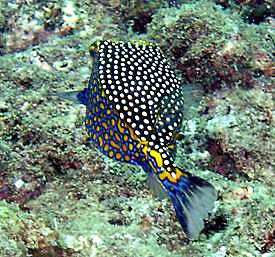 Very good
diving, all drift diving, some strong currents, including down
currents – hhhmm – oh, and dynamite fishing whilst we were in the
water! This was a little scary. The previous day we'd been
out diving around Menjangen Island when we unexpectedly came
across several men diving along side us, breathing in compressed
air from an umbilical cord leading from a boat on the surface.
They had a couple of weights wrapped around their waist but no
other safety equipment, like a gauge to tell them how deep they
were or how long they'd been in the water.
Very good
diving, all drift diving, some strong currents, including down
currents – hhhmm – oh, and dynamite fishing whilst we were in the
water! This was a little scary. The previous day we'd been
out diving around Menjangen Island when we unexpectedly came
across several men diving along side us, breathing in compressed
air from an umbilical cord leading from a boat on the surface.
They had a couple of weights wrapped around their waist but no
other safety equipment, like a gauge to tell them how deep they
were or how long they'd been in the water.
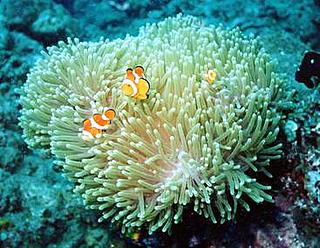 This was not
quite in the protected WWF marine reserve where I mostly dived,
but they most definitely should not have been doing this. They
were no more pleased to see us than me and the dive instructor I
was with, were to see them. They knew they were 'in the
wrong' and it was a very awkward situation under water, a
little aggressive and certainly very threatening. When we got
back to our dive boat, and were returning to our hotel, the
Japanese instructor (a tiny little thing, with the strength of
Goliath) said in Indonesian (which I picked up a fair bit of!) to
the guys on the pirate boat that she was going to call the
police. They were not impressed.
This was not
quite in the protected WWF marine reserve where I mostly dived,
but they most definitely should not have been doing this. They
were no more pleased to see us than me and the dive instructor I
was with, were to see them. They knew they were 'in the
wrong' and it was a very awkward situation under water, a
little aggressive and certainly very threatening. When we got
back to our dive boat, and were returning to our hotel, the
Japanese instructor (a tiny little thing, with the strength of
Goliath) said in Indonesian (which I picked up a fair bit of!) to
the guys on the pirate boat that she was going to call the
police. They were not impressed.
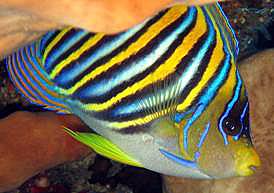 The next day
we dived in a different part of the same marine sanctuary, when
we heard this massive boom. There is only one sound, that, even
under water sounds like that – explosives. I was rather scared,
to put it mildly! Someone close by was dynamite fishing. It was
not a good feeling, and I thought that maybe, just maybe, my time
was up, and this is how it was all going to end – making enemies
with Indonesians stealing tropical fish who dynamited us out of
the water for revenge. But, as you can see, they did not dynamite
us, but there were four explosions on that dive and they were
further away than I first thought, but it was still very scary,
the whole water and landscape seems to vibrate and shake, almost
as if it was crying.
The next day
we dived in a different part of the same marine sanctuary, when
we heard this massive boom. There is only one sound, that, even
under water sounds like that – explosives. I was rather scared,
to put it mildly! Someone close by was dynamite fishing. It was
not a good feeling, and I thought that maybe, just maybe, my time
was up, and this is how it was all going to end – making enemies
with Indonesians stealing tropical fish who dynamited us out of
the water for revenge. But, as you can see, they did not dynamite
us, but there were four explosions on that dive and they were
further away than I first thought, but it was still very scary,
the whole water and landscape seems to vibrate and shake, almost
as if it was crying.
 We are sorry
to say that Mac is not very well, but he is still e-mailing
strong and recently sent the Beetle a collection of travel
reminiscences about China.
We are sorry
to say that Mac is not very well, but he is still e-mailing
strong and recently sent the Beetle a collection of travel
reminiscences about China.
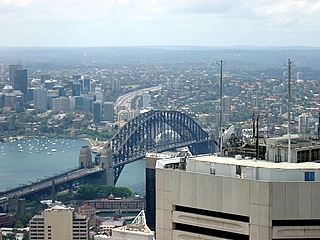 Start in Sydney’s south at the Royal National
Park, the 2nd oldest national park in the world, after Yellowstone. On
Sunday’s you can take the train to Loftus station and then get a tram
right into the park. It’s a short walk from the tram to the visitor’s
centre, where maps and information about trails are provided.
Start in Sydney’s south at the Royal National
Park, the 2nd oldest national park in the world, after Yellowstone. On
Sunday’s you can take the train to Loftus station and then get a tram
right into the park. It’s a short walk from the tram to the visitor’s
centre, where maps and information about trails are provided. 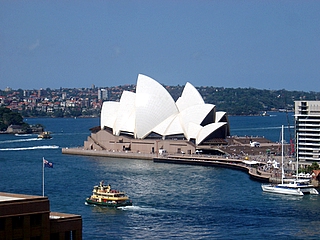 Some trails are challenging, but there is something for everyone and
you can spot many native animals in their natural habitat (just steps
from the visitor’s centre we spotted a Lyre bird, several rainbow
lorikeets and rosellas, white cockatoos as well as the more rare black
variety). It is quite calming listening to all the sounds of the bush
and to know that in one hour you can be back in the city centre and be
shopping in some of the best stores and eating in the best restaurants.
Available too are hire boats to row on the lake, picnic areas and a
place to buy a meat pie, should all that walking make you hungry for
some good Aussie tucker.
Some trails are challenging, but there is something for everyone and
you can spot many native animals in their natural habitat (just steps
from the visitor’s centre we spotted a Lyre bird, several rainbow
lorikeets and rosellas, white cockatoos as well as the more rare black
variety). It is quite calming listening to all the sounds of the bush
and to know that in one hour you can be back in the city centre and be
shopping in some of the best stores and eating in the best restaurants.
Available too are hire boats to row on the lake, picnic areas and a
place to buy a meat pie, should all that walking make you hungry for
some good Aussie tucker. 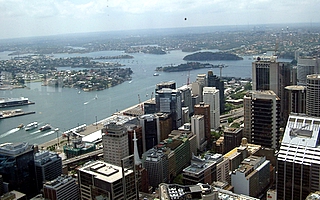 It’s also good to know the Harbour foreshore and most beaches now have
wonderful walking trails as well. You can walk from Darling Harbour,
around The Rocks and Circular Quay and around to Mrs. Macquarie’s Chair
and Darlinghurst along one trail and take the ferry to Taronga Zoo on
the other side and walk still another trail there.
It’s also good to know the Harbour foreshore and most beaches now have
wonderful walking trails as well. You can walk from Darling Harbour,
around The Rocks and Circular Quay and around to Mrs. Macquarie’s Chair
and Darlinghurst along one trail and take the ferry to Taronga Zoo on
the other side and walk still another trail there. 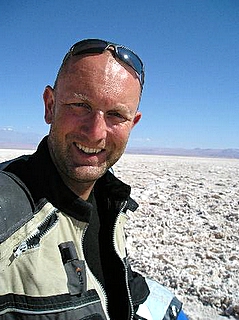 My name is Greg McKenzie
and I’m currently taking a break from earning a living to do something
which has festered in the back of my mind for a while now – a major
motorcycle trip.
My name is Greg McKenzie
and I’m currently taking a break from earning a living to do something
which has festered in the back of my mind for a while now – a major
motorcycle trip. 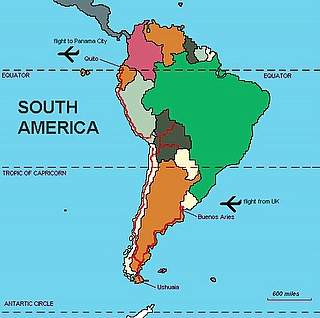 I land
in Buenos Aries, Argentina on 21st January 2005,
briefly travelling north to visit Montivideo, Uruguay
before turning south heading for Ushuaia, just short of Cape Horn.
I land
in Buenos Aries, Argentina on 21st January 2005,
briefly travelling north to visit Montivideo, Uruguay
before turning south heading for Ushuaia, just short of Cape Horn. 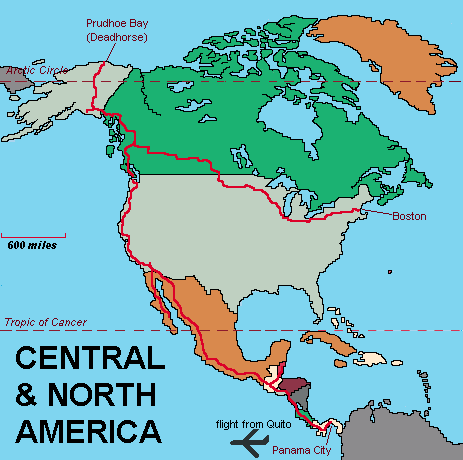 I intend to visit the Baja peninsula for
some sea-kayaking and more trekking before continuing up into the USA
stopping at Los Angeles and San Francisco on the way.
I intend to visit the Baja peninsula for
some sea-kayaking and more trekking before continuing up into the USA
stopping at Los Angeles and San Francisco on the way. 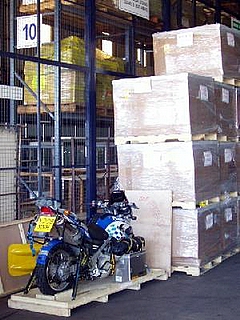 This morning I swapped the rather average
hotel breakfast for a much better offering from a café on
Plaza del Mayo. Coffee so think it could stand for election. A few
photo´s are attached below to get a flavour of the city. In
truth I´m still seeing the parts of B.A. that some Minister
of Tourism encourages us to see. Despite taking a stroll away from the
tourist / shopping centre today towards the more
´bohemian´ San Telmo barrio this afternoon (lots of
shaded cobbled streets and quaint antique shops) I´m still on
the tourist trail I think.
This morning I swapped the rather average
hotel breakfast for a much better offering from a café on
Plaza del Mayo. Coffee so think it could stand for election. A few
photo´s are attached below to get a flavour of the city. In
truth I´m still seeing the parts of B.A. that some Minister
of Tourism encourages us to see. Despite taking a stroll away from the
tourist / shopping centre today towards the more
´bohemian´ San Telmo barrio this afternoon (lots of
shaded cobbled streets and quaint antique shops) I´m still on
the tourist trail I think.  Framed by glowing sunsets and a bountiful
canopy of stars, lies the Kruger National Park. The park, rich in
biodiversity, was established in 1898 and stretches for 350km (approx
140 miles – within the park itself the road network measures in at
about 1300 miles) from the south to north along the Mozambican border
before meeting up with the Zimbabwean border. A paradise for the
wildlife enthusiast with close to 150 mammals to be on the look-out
for, amongst them six cat species, the park also has more than 500
species of birds and over 300 species of trees for the visitor to
identify. With its subtropical climate, the large habitat variety and a
surface area of 19 633km², the park is home to a spectacular
array of fauna and flora and is undoubtedly the world leader in dynamic
environmental management techniques and policies based on experience
gained over more than a century.
Framed by glowing sunsets and a bountiful
canopy of stars, lies the Kruger National Park. The park, rich in
biodiversity, was established in 1898 and stretches for 350km (approx
140 miles – within the park itself the road network measures in at
about 1300 miles) from the south to north along the Mozambican border
before meeting up with the Zimbabwean border. A paradise for the
wildlife enthusiast with close to 150 mammals to be on the look-out
for, amongst them six cat species, the park also has more than 500
species of birds and over 300 species of trees for the visitor to
identify. With its subtropical climate, the large habitat variety and a
surface area of 19 633km², the park is home to a spectacular
array of fauna and flora and is undoubtedly the world leader in dynamic
environmental management techniques and policies based on experience
gained over more than a century.  Most
national parks also offer organised night drives or early morning
drives in park vehicles with guides, but they have to stay on the road
and take place at set times, so many people hire a car themselves to
explore the parks on their own. Most parks have rest camps, and
— depending on the park – a range of accommodation,
from camps and huts to bungalows and guest houses. Most accommodation
is equipped with self-catering facilities, although many camps do have
shops, and some have restaurants.
Most
national parks also offer organised night drives or early morning
drives in park vehicles with guides, but they have to stay on the road
and take place at set times, so many people hire a car themselves to
explore the parks on their own. Most parks have rest camps, and
— depending on the park – a range of accommodation,
from camps and huts to bungalows and guest houses. Most accommodation
is equipped with self-catering facilities, although many camps do have
shops, and some have restaurants.  In
the winter, when water is scarce and the plant life dies back, the
animals are easier to spot, especially at water holes and riverbeds.
This is the most popular season, so be prepared to share your safari
with other motorists. The days are warm, but temperatures can drop
close to freezing at night, and units are not heated. Try to avoid
going during the school holidays, particularly in winter, when the park
is packed to capacity.
In
the winter, when water is scarce and the plant life dies back, the
animals are easier to spot, especially at water holes and riverbeds.
This is the most popular season, so be prepared to share your safari
with other motorists. The days are warm, but temperatures can drop
close to freezing at night, and units are not heated. Try to avoid
going during the school holidays, particularly in winter, when the park
is packed to capacity. 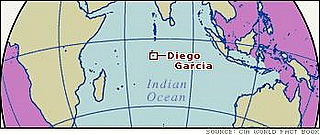 The
The
 Buckingham
Palace has served as the official London residence of Britain’s Kings
and Queens since 1837. Built by George VI on the site of the King’s
House, Pimlico, the shell of which was preserved by Nash, the
architect. Marble Arch once stood in front, but it was later removed to
the western end of Oxford Street where the famous Tyburn Gallows once
stood. When Queen Victoria moved here in 1837, just 10 years after the
works had been carried out, it was barely habitable. There are 600
rooms in the Palace, of which under twenty can be visited, as well as
the Queen’s Picture gallery and the Mews.
Buckingham
Palace has served as the official London residence of Britain’s Kings
and Queens since 1837. Built by George VI on the site of the King’s
House, Pimlico, the shell of which was preserved by Nash, the
architect. Marble Arch once stood in front, but it was later removed to
the western end of Oxford Street where the famous Tyburn Gallows once
stood. When Queen Victoria moved here in 1837, just 10 years after the
works had been carried out, it was barely habitable. There are 600
rooms in the Palace, of which under twenty can be visited, as well as
the Queen’s Picture gallery and the Mews.